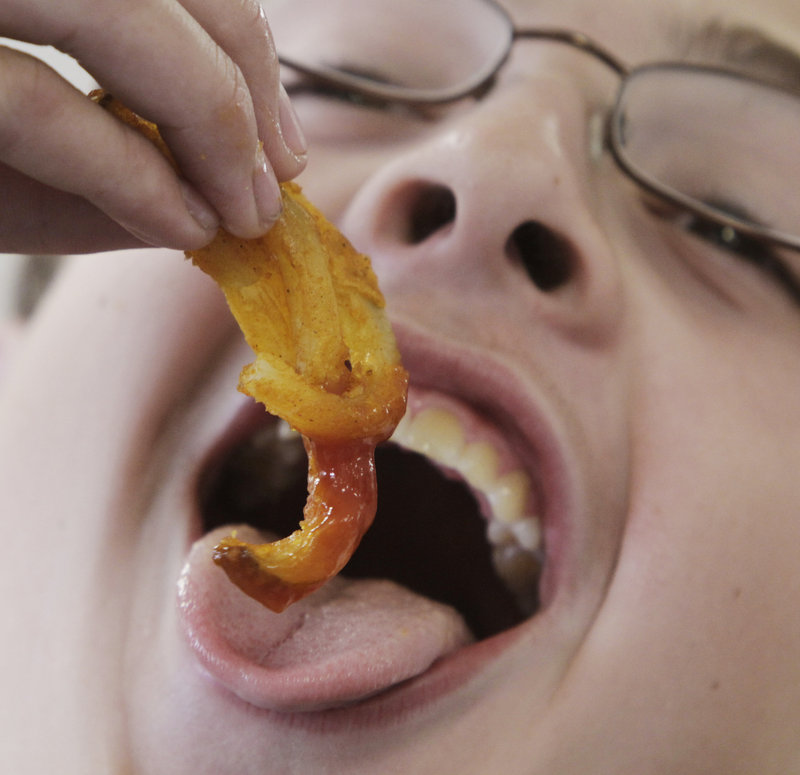PORTLAND — Sen. Susan Collins, who is from Maine’s potato country and picked potatoes as a girl, is working to restore some respect for the humble spud, which is on the verge of being banished from the nation’s school lunch programs.
New guidelines from the U.S. Department of Agriculture would eliminate potatoes from school breakfasts and drastically reduce the amount of potatoes in lunches.
Collins, R-Maine, said the unassuming white potato has its place alongside more highfalutin vegetables in school cafeterias. She said potatoes are healthy, as long as they’re not fried.
“I certainly agree that french fries is not the healthiest choice, but a baked potato can be a good source of potassium for our children,” said Collins, who has enlisted Democratic Sen. Mark Udall of Colorado, another potato-growing state, to help her fight the anti-spud movement.
Collins and Udall will attempt to strip funding to implement the new guidelines when the USDA appropriations bill goes to the Senate floor, in the coming weeks or months. The House-approved USDA appropriations bill already prohibits funds from being used to further the proposed USDA guidelines.
The proposal announced by the USDA in January puts focus on fruits, vegetables and whole grains while limiting sodium, banning trans fats and reducing starches.
The guidelines would limit starchy vegetables — corn, peas and lima beans, in addition to potatoes — to two servings a week. That’s about one cup.
Potato growers across the nation claimed the first major nutritional overhaul of students’ meals in more than a decade unfairly singled out and stigmatized spuds, which already took their lumps along with pasta and bread and other carbo-loaded foods during the low-carb diet craze a few years ago.
Many scientists insist there are better alternatives.
A medium-sized potato packs up to 220 calories and has been associated with weight gain in the U.S., said Dr. David Heber, director of the UCLA Center For Human Nutrition and author of “What Color Is Your Diet?”
And folks needn’t feel sorry for potato-loving kids, he said.
“They’re not going to stop eating potatoes. They’ll be eating them at home, and they’ll be eating them in restaurants,” Heber said.
The National Potato Council says the proposal would carry a large cost to farmers in lost sales, as well as a $6.8 billion cost for school districts that will have to buy more costly foods.
And some questioned whether reducing potato consumption at school would yield big improvements in children’s health.
Putting an increased emphasis on physical education would have a far greater impact on reducing childhood obesity, said Tim Hobbs, the Maine Potato Board’s development director.
“There’s other ways to address childhood obesity. I don’t know that limiting potatoes in the school lunch program is going to have the desired impact,” Hobbs said.
Virtually all agree that the problem is the french fry, a ubiquitous item on school menus in many parts of the country, sometimes getting served every day.
But some argue that getting rid of the french fry doesn’t require getting rid of the potato.
Heidi Kessler, school nutrition manager for Let’s Go, a program aimed at fighting childhood obesity at the Barbara Bush Children’s Hospital at Maine Medical Center, supports the goals of the proposed guidelines. But she agreed with Collins that the USDA should have focused on the way potatoes are prepared, targeting french fries instead of all white potatoes.
“They’re inexpensive, kids like them and they’re easy to store,” she said, “and they absolutely have nutrient value that can contribute to a healthy diet.”
Copy the Story Link
Send questions/comments to the editors.



Success. Please wait for the page to reload. If the page does not reload within 5 seconds, please refresh the page.
Enter your email and password to access comments.
Hi, to comment on stories you must . This profile is in addition to your subscription and website login.
Already have a commenting profile? .
Invalid username/password.
Please check your email to confirm and complete your registration.
Only subscribers are eligible to post comments. Please subscribe or login first for digital access. Here’s why.
Use the form below to reset your password. When you've submitted your account email, we will send an email with a reset code.